Swine flu
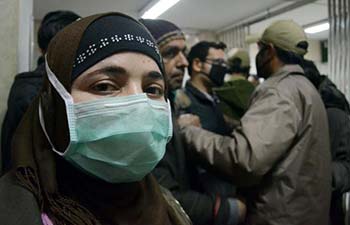 Swine flu or H1N1 is a reality now. We cannot just shut our eyes and ears and wish it away. With 80 people tested positive and 8 death so far, the threat of an epidemic is looming over the skies of Kashmir. But ironically doctors in Kashmir are still hung up in a denial mode. Rather than making people aware about the threat of Swine Flu doctors are passing the buck.
Swine flu or H1N1 is a reality now. We cannot just shut our eyes and ears and wish it away. With 80 people tested positive and 8 death so far, the threat of an epidemic is looming over the skies of Kashmir. But ironically doctors in Kashmir are still hung up in a denial mode. Rather than making people aware about the threat of Swine Flu doctors are passing the buck.
Interestingly, it was two years back that the alert was sounded across India regarding Swine Flu. Being a tourist destination, authorities established screening points at the Srinagar airport to monitor the people coming in. But they failed to maintain such screening on the highway, which connects the state with India, from where most of tourists enter valley.
It took doctors and state health machinery almost two weeks to react to the situation that many believe has already entered into a crucial phase. Government has finally started two isolation wards, one each at Chest Diseases Hospital and LD Maternity Hospital. Authorities maintain that these isolation wards and testing labs will help in reducing the pressure on SKIMS.
Hospital sources informed that SKIMS has improved its H1N1 management overnight. Now the staff managing the testing facility is better protected – compared to earlier situation, and access to the testing facility is regulated adequately. But two years ago, an isolation ward was created at SKIMS which, now has been renovated for some other purpose.
Once a patient is tested positive, they are classified in two categories. In one category, patients need medicine and can rest at home with adequate protections. The other category requires admission in the hospital in a specialized, isolated ward where they could have access to ventilators, if required.
Meanwhile Epidemiologist and Head, Regional Institute of Health and Family Welfare, Dr SM Qadri has said that H1N1 virus cannot be controlled as it is present in community now.
So better would be, if precautionary measures will be taken instead.
The Governor, NN Vohra has also informed the state health officials to provide all facilities needed for patients suffering from this virus. He was informed that SKIMS had so far taken 670 samples of persons from different parts of the State and tested 275 samples, out of which 71 patients had tested positive for Swine Flu virus.
But as per sources, state lacks the medicines used for this virus and the prescribed masks, N95.
Poisonous pepper
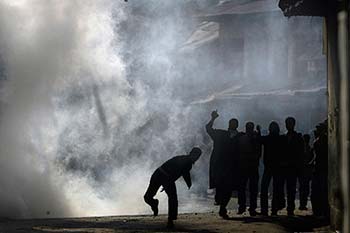 This past week, the concern of old city people found a voice. A pepper gas torture, which residents of old Srinagar have been crying hoarse over the past few years now was finally condemned by the senior Hurriyat leader Javaid Mir.
This past week, the concern of old city people found a voice. A pepper gas torture, which residents of old Srinagar have been crying hoarse over the past few years now was finally condemned by the senior Hurriyat leader Javaid Mir.
Condemning the use of poisonous pepper gas by police while dispersing protestors in various parts of Srinagar including Saraf Kadal, Habba Kadal and other parts of the Valley, Mir said it resembles the brutality of Israel over the Gaza.
“Despite repeated calls by many human right groups and the civil society, it is ironical that police is still using pepper gas in the Valley against peaceful protesters. This is against international covenants of human rights which the forces are using,” he said.
Mir said people living in these areas particularly new born babies, asthma patients, pregnant women are facing non-bearable problems due to pepper gas explosions and also the risk of death.
Quoting the famous writer Alva Myrdal, Javaid Mir said: “The age in which we live can only be characterized as one of barbarism. Our civilization is in the process not only of being militarized, but also being brutalized seems to fittingly describe the sad state of affairs in Kashmir in wake of unabated human rights abuses by men in uniform.”
“Painfully enough, the poisonous pepper Gas is now suffocating and killing people in Kashmir as it is being indiscriminately used to quell protests especially in Down Town Srinagar,” he added.
Engineering Jamaat!
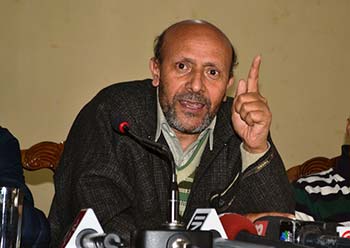 The controversy surrounding MLA Langate Engineer Abdul Rasheed making a speech at the Jamaat-e-Islami held conclave in Jammu refuses die down.
The controversy surrounding MLA Langate Engineer Abdul Rasheed making a speech at the Jamaat-e-Islami held conclave in Jammu refuses die down.
Immediately after the conclave was over there were voices of dissent within the Jamaat questioning the motive behind inviting a “pro-India politician”. Later that day, Jamaat came out with an official press note saying that inviting Er. Rasheed was a mistake. But that was not all. A probe was ordered to know who exactly has invited Er. Rasheed. Days later, Jamaat expelled two its district president Jammu, Abdul Kareem and caretaker of the mosque Ghulam Nabi Fareedabadi, for inviting a sitting law-maker.
The senior members of Jamaat hushed up the matter and said they were not aware about the invitees and were kept in the ‘dark.’
As per Jammat rules, there is a tradition in Jammu that when Jama’at conducts congregation, non-Muslims are invited as well. They participate in interaction sessions, but inviting a pro-Indian politician is against the Jamaat rules.
The spokesperson of Jammat termed the incident as unfortunate and said, “It has not only shaken the inner circles of Jama’at but also its sympathizers”. “A negative effect has prevailed. People think Jama’at has retracted from its stand on Islam and ‘Azadi’. There is no question of a sell-out. But, we assure all the people including pro-freedom groups and our supporters and sympathizers that we haven’t changed our stance when it comes to Kashmir issue or Islam.”
Jamaat spokesman officially reiterated party’s stand over Kashmir and said until the long-pending issue is not solved according to United Nations Resolutions, the Jama’at would continue to ‘struggle shoulder-to-shoulder with other pro-freedom parties and groups’.
Meanwhile, on February 23, JeI is going to call a special session of party’s advisory council where the issue will be discussed. If speculations are to be believed this incident may see some heads rolling in Jamaat.
Chronicling Floods
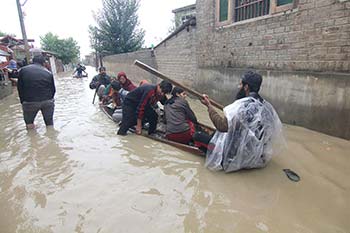 September 7, 2014 floods that devastated major parts of the valley will go down in this Himalayan state’s history as one of the worst natural disasters. And chronicling it is what will keep it alive for the generations to come. With that aim, Tarique Bhat, a Kashmiri filmmaker, recently released his documentary titled ‘Kashmir: Into the Murky Waters’. The 52 minute film, which is a collection of visuals mostly shot during floods by Associate Media’s dare-devil team, talks about issues that go beyond blame-the-nature syndrome.
September 7, 2014 floods that devastated major parts of the valley will go down in this Himalayan state’s history as one of the worst natural disasters. And chronicling it is what will keep it alive for the generations to come. With that aim, Tarique Bhat, a Kashmiri filmmaker, recently released his documentary titled ‘Kashmir: Into the Murky Waters’. The 52 minute film, which is a collection of visuals mostly shot during floods by Associate Media’s dare-devil team, talks about issues that go beyond blame-the-nature syndrome.
The film is a reflection of present day Kashmir and its inhabitations, who for their petty gains, ended up playing collaborators in the making of this disaster.
With the help of visuals the film helps audience to understanding the reasons, both natural and man-made, that led the loss of around 300 lives and damage to property worth 1 trillion rupees.
The one thing that stands out about ‘Kashmir: Into the Murky Waters’ is the way director Tarique Bhat has exposed the historic failure of government in command during floods. With intelligently woven visuals and narration, the film helps in understanding the helplessness of people in command. It simply strips these officials of their super-human status.
Another standout point of this documentary is the way director has justified 52 minutes of screen time. The film helps one understand that floods are not just caused by rains or cloud bursts, it is a result of many small undetected selfish interests that we often justify for our own gains.
The film, if screened widely, is sure to raise many questions on the way we have been treating our surrounding. But more importantly, it will help future generation to understand how their forefathers contributed in the making of an irreversible cycle of destruction.
PanthChowk Pain
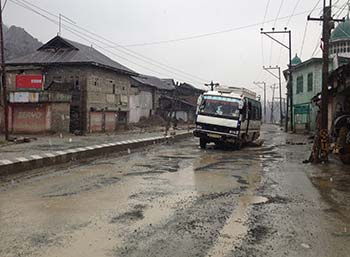 It takes almost two hours to reach Srinagar from adjoining Pampore town. The distance between two places is just 12 kms! In last two years the stretch between Sempora and Pantha Chowk was laid, re-laid, filled, re-filled, macadamized, re-macadamized, dug up, filled, then again dug up and filled, at least 30 times. But the problem of traffic jam refuses to go away. It is this less-than 2 km stretch that has held hostage entire valley as the road connects Srinagar city to South Kashmir and beyond. But nobody seems to care. There are just quick-fixes and nothing beyond that.
It takes almost two hours to reach Srinagar from adjoining Pampore town. The distance between two places is just 12 kms! In last two years the stretch between Sempora and Pantha Chowk was laid, re-laid, filled, re-filled, macadamized, re-macadamized, dug up, filled, then again dug up and filled, at least 30 times. But the problem of traffic jam refuses to go away. It is this less-than 2 km stretch that has held hostage entire valley as the road connects Srinagar city to South Kashmir and beyond. But nobody seems to care. There are just quick-fixes and nothing beyond that.
Ask anybody who is a frequent traveler on this stretch that how is the experience and he, without losing any time, will snap back, almost emotionally, that it is nothing short of driving through a stream or a brook. The stretch once upon a time used to have a proper road that people drove on. But all that is left are rocks, water, mud and sings of a road.
The stretch, which has become a bottle-neck for traffic and a reason of pain and agony for travelers, is remnant of government’s ill conceived plans.
It takes just will and good sense, and a little bit of engineering and planning to rid commuters of this pain forever. But who is going to take that much of pains for sake of people!















